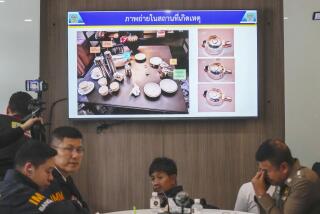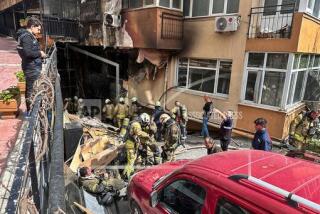FBI Searches Debris in Bali
KUTA, Indonesia — KUTA, Indonesia--An FBI team sifted through the debris of Indonesia’s worst terrorist attack Sunday, searching for clues to the identity of those who detonated a car bomb in a popular Bali nightclub district crowded with foreign tourists.
Authorities said the attack Saturday night killed at least 184 people and wounded 490. Dozens were still missing, and the death toll was expected to rise. Police at the scene said bodies remained buried in the rubble of the Sari Club, which was packed with foreigners when the car bomb exploded nearby.
Two Americans were confirmed dead and three others were among the hundreds of people injured, a U.S. official said. At least one other American, Steven Brooks Webster, 41, of Huntington Beach, remained unaccounted for.
The dead and wounded came from more than 25 nations and represented six continents, although most of the victims were Indonesian or Australian.
Officials in Australia said more than 200 Australians remained unaccounted for. Prime Minister John Howard called the bombing a national tragedy.
Grief-stricken survivors searched Bali’s 13 hospitals for friends and loved ones missing since the Saturday night blast.
Indonesian officials branded the bombing a terrorist attack, but there was no indication whether it was connected to the Al Qaeda terrorist network or other Islamic extremist groups that have been operating in Southeast Asia.
But in recent days, U.S. officials have been warning that Al Qaeda could be preparing a new series of attacks, and some officials said Sunday that the bombing could be part of that series.
Richard C. Shelby of Alabama, the ranking Republican on the Senate Intelligence Committee, predicted as much, saying more attacks could occur “perhaps in the United States.”
Brig. Gen. Saleh Saaf, the Indonesian police spokesman, said it was “premature” to draw any conclusions about who was behind the attack. The bomb was placed in a Toyota Kijang van and apparently detonated by remote control.
In Washington, President Bush denounced the bombing as “a cowardly act designed to create terror and chaos.... We must call this despicable act by its rightful name, murder.”
The State Department ordered U.S. government personnel in nonessential positions and embassy families out of Indonesia because of the threat of more terrorist attacks.
Some extremist Muslim leaders asserted that the bombing was carried out by the United States in a plot to embarrass Indonesia and undermine the radical Islamic movement. As proof, they pointed to the low number of American casualties.
U.S. officials immediately denied the claim.
“These statements are totally outrageous and completely false,” said one American official who asked not to be identified.
In the Kuta district of Bali, witnesses and survivors Sunday described a scene of horror from the night before, with severed heads and limbs strewn around the streets in front of the Sari Club.
One motorcyclist said the blast was so powerful that he saw a car thrown through the air.
Many of those injured suffered serious burns or lost arms or legs.
On Sunday, many foreign visitors were in a state of shock and bewilderment. Some marveled at their narrow escape. Others were gripped by despair as they realized that missing friends probably would not be found alive.
John Woodley, a bandage over his left cheek and ear, returned to the scene of the explosion Sunday afternoon to see the devastation he escaped.
The Sari Club, where he had been drinking the night before, was leveled, except for the twisted metal frame of its sign, which was turned on end and pointing oddly toward the sky.
All around were buildings gutted by fire, including a bank and another bar that had been crowded that night, Paddy’s Irish Club. Glass and debris littered the nearby streets, and the smell of smoke hung in the air. Dozens of police officers kept sightseers at bay.
Woodley, a 28-year-old Londoner, said he was standing in the center of the packed nightclub when the car bomb exploded, destroying the building in an instant.
The corrugated metal roof collapsed on the crowd, he said, trapping scores of people.
Woodley said he was knocked to the ground and lost his glasses and sandals.
But somehow, a small hole in the wreckage appeared above him and he crawled through. He ran to safety as the building burst into flames. He suffered only burns on his face and cuts on his leg.
“I was incredibly lucky,” he said. “There were 300 people in there. I cannot imagine that many of them survived.”
At Sanga Hospital, hundreds of Indonesians and foreigners milled around, hoping to find people they hadn’t seen since the explosion. A list of the missing was posted on a wall. A few were marked as found, a few others as dead.
A Swedish tourist, who gave his name only as Bjorn, said he was in the bathroom at the back of the Sari Club when the blast hit.
He hardly knows how he escaped but recalls coming to a high brick wall, where he pushed others over to safety. He doesn’t remember how he got over the wall himself.
The moment of the blast was the first time he had been apart from his girlfriend the entire evening, he said Sunday. He had not seen her since.
After his escape, he helped load five bodies into a car and rode with them to the hospital in the hope of finding her there.
At first he thought the five were the only ones killed and was optimistic he would soon find her. But as the dead bodies piled up, his hopes dwindled.
He searched for her among the dozens of charred, unidentified bodies in the hospital morgue. But even there he didn’t find her.
Sunday evening, nearly 24 hours after the blast, he sat dejectedly at the hospital, watching medics roll the wounded past on gurneys.
“We were about to leave,” he said, staring at the ground. “Another five minutes and we would have been gone.”
One of Saturday’s heroes was Made Swastika, 30, an Indonesian management consultant who was walking near the Sari Club when the car bomb exploded.
In the chaos, he saw a young Swiss woman who had been blown out of the nightclub by the blast and was severely burned.
“I saw this girl badly injured, lying on the street, and nobody helped her,” he said. “She was dying.”
Swastika carried the woman to his motorcycle and drove her to the hospital. Again there was no one to help her, so he got a pair of scissors and cut the clothes off her burns.
After going home briefly to change out of his bloody clothes, he returned and stayed with her through the night and all day until she was airlifted to Singapore.
“I took pity seeing those injured people,” he said.
At the hospital’s makeshift morgue, dozens of medical workers began the laborious process of identifying bodies burned and maimed beyond recognition.
More than 50 corpses were laid out on a covered walkway in the tropical heat amid blocks of ice to keep them cool. Local residents peered over a wall to watch the proceedings.
In some cases, it was possible to take hair samples for DNA analysis. In others, it was necessary to cut the body open and obtain a tissue sample.
Putra Swi Antara was one of a dozen Balinese medical students who was helping out. But foremost in his mind was the effect the bombing would have on Bali, a predominantly Hindu island that until Saturday had been spared much of the turmoil affecting the rest of Indonesia.
Bali, famous for its surfing beaches and terraced rice paddies, depends heavily on tourism. Most Balinese have at least one relative who works in the tourism industry.
Now, some tourists are so frightened that they are leaving their hotels and sleeping at the airport until they can get a flight home.
“The main thing residents are worried about is tourism,” said Antara, 20, as he watched his fellow students take samples from the corpses. “Almost all of the tourists are checking out and departing.”
More to Read
Sign up for Essential California
The most important California stories and recommendations in your inbox every morning.
You may occasionally receive promotional content from the Los Angeles Times.









